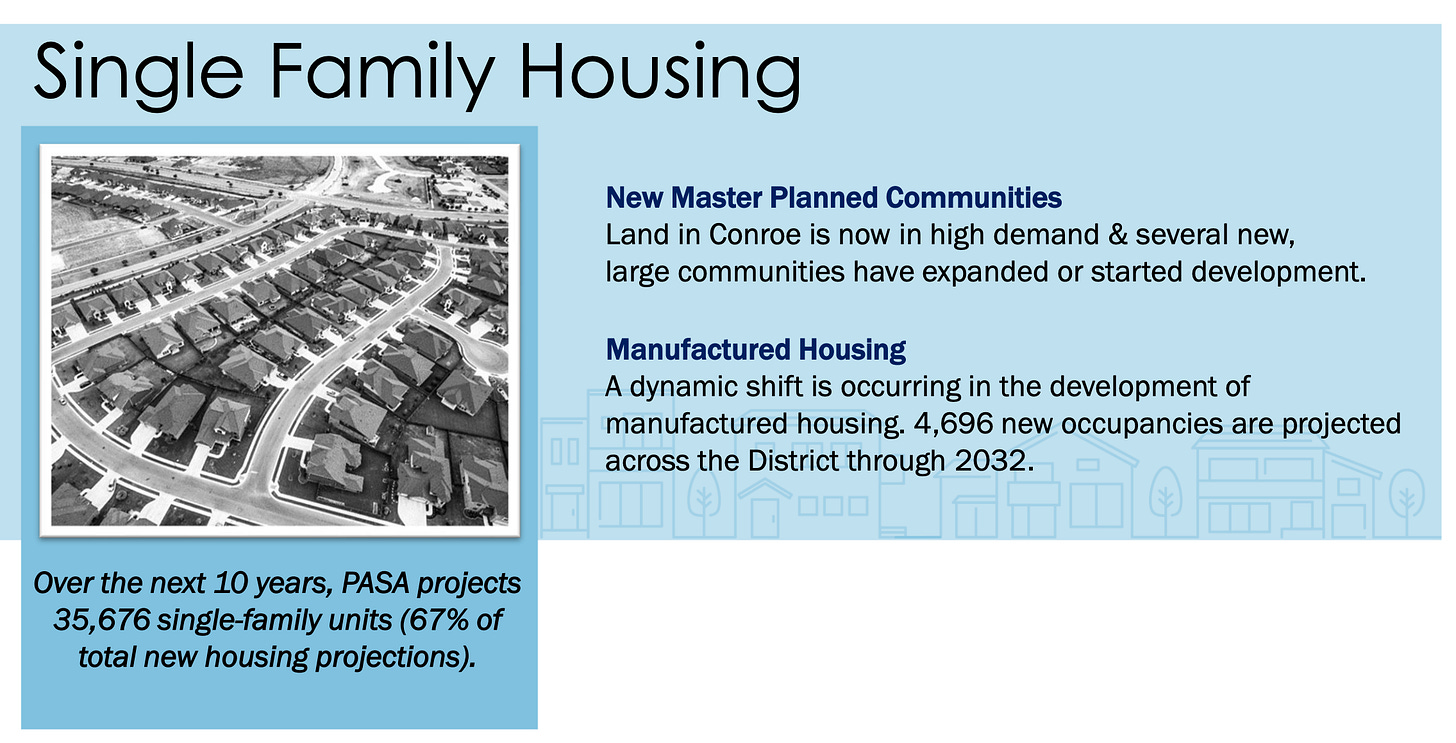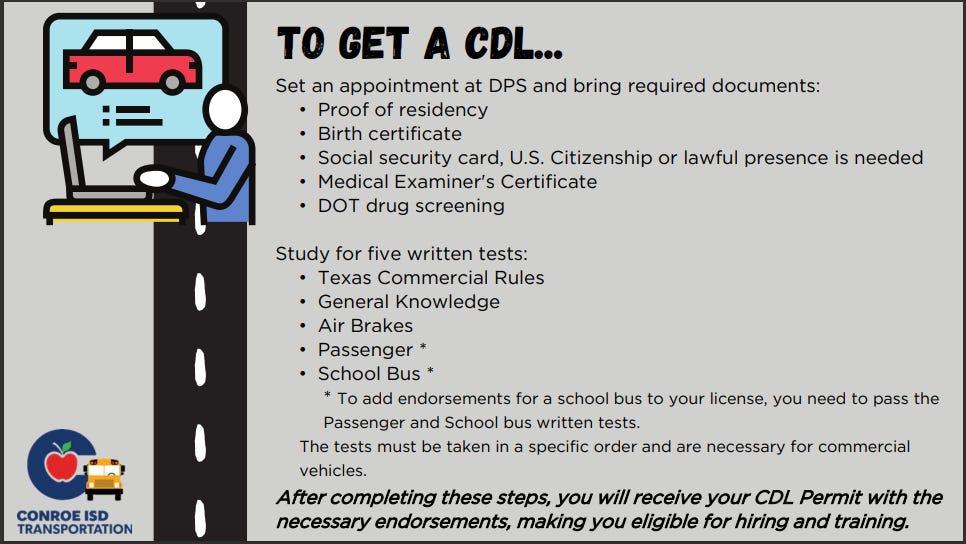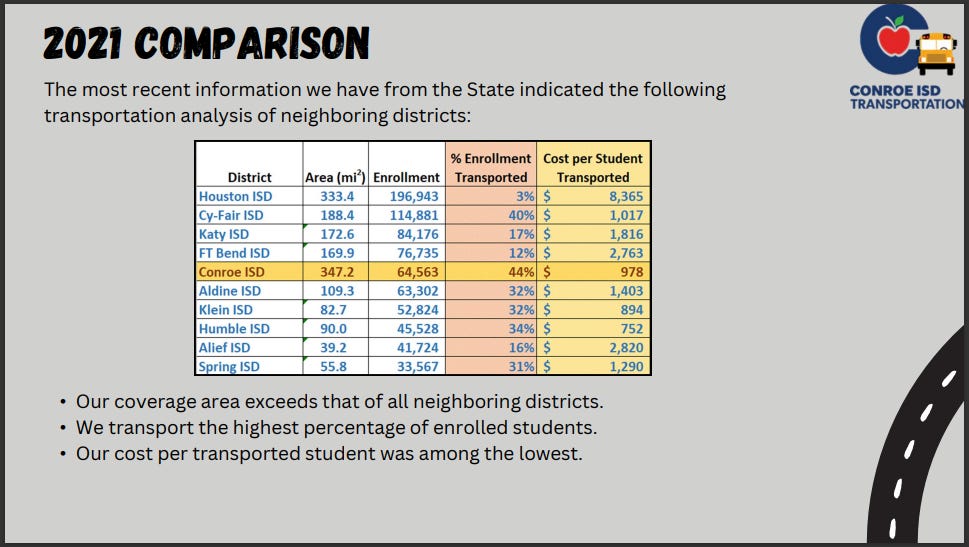Community Collaborative Day 2
Conroe ISD growth, transportation, and a big yellow bus straight off the assembly line.
On the second meeting of the Conroe ISD Community Collaborative group, we learned how growth is calculated and trending within the district, took a trip to an elementary school on a brand spankin’ new bus, and got a crash course on how 600+ buses transport 40,000 students every school day. We were given an insight into how operations work in the 9th largest school district in Texas, and it was honestly a fun day orchestrated by passionate people who love what they do.
To summarize district operations…it ain’t easy.
But before getting into the details of growth and transportation, let’s start with some observations about growth I do not think many people in Montgomery County appreciate.
We Are NOT Keeping Up
Conroe ISD is way behind in keeping up with the growth of the area, but it’s not for lack of trying. There are two primary reasons we see causing this.
#1 We do not fully fund our bonds
When the school district sends a bond to the voter’s booth, which is when the district needs permission to sell bonds that will bring money to build or expand schools, it never sends a bond package that is fully inclusive of all the actual needs of the district.
As compared to other peer districts that fully fund their bonds, Conroe ISD’s Bond Committees go through an intense process of taking what experts are telling us we need to accommodate growth, and then trimming out what will be most palatable to voters in the most conservative area in Greater Houston.
In the 2023 Conroe ISD bond, there was a need of $3 Billion dollars to support growth in the district, yet the Bond Committee finalized on a $1.8 Billion package. That is still a wildly large number for a school district to ask for, yet even with that amount the school tax rate was estimated to increase only $0.02 (latest numbers show there may be no increase).
This was still a tough sell for many voters in November 2023, as only three of the four bond propositions passed. The props that did pass were all around 60% in favor.
Further, the local Montgomery County Tea Party, along with other conservative groups, also instructed voters to vote ‘no’ on all four propositions within the 2023 Bond due to claims of “unknown costs, high inflation, bad timing, not enough information, and unknown number of illegal students.” I find these hard to believe after going through the numerous meetings and presentations given to the 2023 Bond Committee.
In a semi-related note, even the county appraisal district is having difficulty keeping up with valuing property due to the record numbers of appraisal protests. It’s a mess just about everywhere you look.
We can expect continued bonds into the future, where CISD will have to keep asking for money to support district growth. Yet with local support for bonds being difficult to secure, how future bonds turn out is yet to be seen.
#2 Developers aren’t helping
In the past, developers who built neighborhoods would often set aside land for schools, either donating the land or selling it at a discounted rate. Nowadays, developers can stuff hundreds of manufactured homes into the same space, then charge a premium price thanks to the continued high prices of homes. Why make a little money when you can a make a lot instead?
Even getting developers to cooperate with their plans in advance can be a challenge. There are no laws requiring them to coordinate with school districts. Only the county and municipalities have the ability to do that, since building homes requires things like permits, electricity, and water.
Would it ever be possible to require developers to get similar approvals from a school district? I doubt it, but as Texas was the most rapidly growing state in the nation for 2023 (census wise), this problem will continue for all Texas school districts.
Let’s breakdown how growth is calculated.
Growth
The presentation on growth in the district was given by Chris McCord, Assistant Superintendent Operations. He brings a real smooth presentation style, even when having to crunch a seemingly weeks’ worth of content into 30 minutes. The number of services he oversees for the district is a bit absurd, in that he may be doing enough work for three people. He certainly knows his stuff and presents it in a fun yet grounded-in-reality kind of way. The slide deck is here.
How does the school district calculate growth? It includes calculating enrollment projections, long-term estimates, geographic mapping, and a focus to analyze the data as thoroughly as possible.
Since school districts do not have this type of capability in house, it is outsourced, and in Conroe ISD’s case to a small company based out of College Station called Population and Survey Analysts (PASA).
PASA assists with growth projections and estimates for around 45 school districts in the State of Texas. You can see a list of their clients here, which includes Katy, Cy-Fair, Houston, and many other notable school districts.
The last PASA report for Conroe ISD was created in 2022. It’s 308 pages long.
Here are the highlights from the Executive Summary of the report. I encourage you to read all of these bullet points:
The number of annual births to mothers living in Conroe ISD increased steadily between 2016 and 2020 at an average of 2% annually. However, in 2021, births in CISD jumped by 6%, which will yield a bulge in the 2026-27 KG class.
Large, developable tracts of land in Conroe are now in high demand and are being acquired by investors and developers. This is partly due to the lack of large tracts available in northern Harris County and partly because of the District’s location along I-45 and its proximity to major regional employment centers such as City Place and The Woodlands. Surrounding districts, including Humble, northern Cy-Fair, and Klein, are virtually built out, making Conroe ISD the ‘next frontier’ in suburban residential development.
Single-family housing starts in Conroe ISD began increasing significantly in 2018. In the 12-month period ending in June 2022, Metrostudy reported 4,498 new single-family housing starts in Conroe ISD. This figure represents a 127% increase from 2016, when 1,981 starts were recorded, and a 210% increase from 2012.
Existing master-planned communities such as Artavia and Woodson’s Reserve are planning additions and expansions. Several new subdivisions have announced plans since the 2018 study, including Mavera, Evergreen, Silverthorne, and Sweetwater Ridge. The six developments mentioned above are projected to add nearly 13,000 occupancies over the next ten years.
A dynamic shift that affects student projections in this study is manufactured housing. More than seven times as many manufactured homes (4,696) are projected to be occupied in this study than there were in the previous study (655), making this one of the most significant changing dynamics in the District. PASA is starting to see the acquisition and development of manufactured home subdivisions across Texas, and portions of Conroe ISD are prime spots for these developments, with the availability of more affordable land and relatively lax land use restrictions.
The report goes through numerous different areas including the following:
Demographics Studies - studies student residential locations, potential growth, housing trends, and economic factors inherent to the district.
Housing Projections - uses past and estimated future trends to develop projections for each active and planned subdivision and apartments.
Current Students - evaluates where current students are residing and if those students are slowly aging out of a district without younger students moving in.
Student Projections - enrollment projections based on past rates and projected future rates.
Note that all of the items above include data on local charter and private school student enrollments. I highly recommend you scroll through the report.
We should also note Conroe ISD is not the only school districts with expansive growth:
One of the key methods of growth calculation is figuring out which types of homes are going to be built, then using the PASA demographic estimate to calculate how many students will need a school:
Single-family homes - .56 children/home
Multi-family (apartments) - .28 children/home
Mr. McCord joked that we only deal in whole children, not .56 or .28, but these estimates become important when deciding where schools need to either expand or be built.
For example, development in Spring Branch Crossing estimates 1,230 single-family homes will be built from 2022 to 2032.
1,230 x .56 = 688.80 students
Within PASA’s estimates for Conroe ISD, 35,676 single-family homes are projected to be built by 2032. That’s nearly 20,000 students to serve in the next eight years.
Do we have the capacity to absorb that many students?
The Governor’s voucher program makes more sense when you consider how much private money can be made in the next decade.
After reading through most of the PASA report, it becomes glaringly obvious that our school board may not be focused on the right priorities. Removing books and spending hours debating things like rainbow posters or committee bylaws is definitely not a good use of a time when we have seemingly insurmountable issues ahead of us in the next decade.
Not to mention the continued staff shortages as educators exit the profession due to lack of support, terrible pay, and an ever-increasing politicalization of public education.

Transportation
After Chris McCord’s presentation, we all piled onto a big yellow bus. I hadn’t been on one of these buses in probably 25 years, so it definitely felt smaller than I remember. It was certainly nicer than what we had in Latexo, TX. This was a brand-new bus, loaded with all the latest bells and whistles.
We took a 10-minute trip down to Suchma Elementary School, and during the drive we were given a tourist-style presentation by the new Director of Transportation, Juan Melendez. It felt like we were touring a city, with Mr. Melendez on the microphone going through their transportation metrics. He, like many people who work in the district, are clearly passionate about the work they do, and they certainly have a knack for making things fun.
He provided a ton of facts about how transportation works within Conroe ISD, both to and from Suchma Elementary. He then gave us a further breakdown back at the Jett Center. The slide deck is here.
We could go through all of the slides about transportation, but I encourage you to read the deck for yourself as it is a well-built presentation and easy to follow. Here are the highlights:
Mission Statement: “The Transportation Department values safety, efficiency, and excellence in transporting students. We prioritize the well-being of students and employees while aiming to enhance operations and maintain community trust.”
Conroe ISD transportation has 217 employees that work out of four transportation centers.
40,000 students are transported in over 2,000 bus runs every day, logging over 7,000,000 miles annually.
8,000 field trips are completed yearly.
Mr. Melendez reiterated several times, “We don’t leave anybody behind.” Making sure students are picked up is vital to their mission.
Bus Drivers
The district assists potential new bus drivers with earning their Commercial Driver’s License (CDL), including training and help to study for the five written tests they must pass.
To get a CDL requires the following, and separately as part of the school district, a clean background check:
The interesting thing is that the bus drivers are hired before they can legally drive a bus. The district assists with the process to get their CDL and completing the training and skills tests. This is basically the only way they can get new bus drivers into the district.
This can complicate things when bus drivers get burned out. They can take their CDL to go work in Oil & Gas where the pay is better and their cargo doesn’t talk back.
Outside of bus drivers there is an Operations Team that clocks in at 4:30am to begin the day, secure bus routes, manage driver call-ins, monitor routes and maintain contact with drivers throughout the day, and when needed, get behind the bus steering wheel themselves. Even Mr. Melendez has had his own bus routes.
There are shop techs that get buses out of the barn, assist with breakdowns or emergency calls, perform repairs, inspections, preventative maintenance, and pull videos to archive for administrators.
There is an entire process to manage bus routes based on student demographics (e.g., where they live, grade levels served, etc.), all of which must be managed daily. There’s even a calculation, approved by the Board, on how far certain students can walk to a bus stop:
If you go through the rest of the slide deck you will likely find answers to commonly asked questions, including info about transporting special education students, stats on the bus fleet, managing bus temperature, challenges on the age of the buses, supply chain issues, and space constraints. It covers a lot of material.
There were some questions by the group around discipline on the bus, which I noted that issues are referred to the student’s campus to deal with. Bus drivers are given extensive training related to discipline, as well as work to implement seating charts (as best as possible) and focus on keeping kids in those seats. This prevents most issues.
Another group discussion was on inclement weather days and how transportation absolutely plays into decisions on when to close the district. This topic could add 1,000 more words to this post, so we’ll save this for another rainy day.
To close out, an important note I took away is that similar to student achievement (i.e., money spent per student vs STAAR scores), Conroe ISD transportation seems to do more with less, as highlighted here:
That completes the second meeting of the Community Collaborative group! We have another one in mid-April, so we’ll check back in then.
Thanks for reading!
Collab Meeting Summaries:
Meeting 1: Intro to Conroe ISD, Finance, Procurement
Meeting 2: Growth & Transportation
Meeting 3: Staff Development, Recruitment, Retention
Meeting 4: CTE, SPED, Extracurriculars, Zoning
Meeting 5: Planning & Construction, School Safety, Summer School














